Related Research Articles

Lawrence Wendell Pfohl, better known by the ring name Lex Luger, is an American retired professional wrestler, bodybuilder, and football player. In 2011 he began working with WWE on its wellness policy. He is best known for his work with Jim Crockett Promotions, World Championship Wrestling (WCW), and the World Wrestling Federation.

Curtis Michael Hennig was an American professional wrestler. He performed under his real name for promotions including the American Wrestling Association (AWA), the World Wrestling Federation, World Championship Wrestling (WCW), and NWA Total Nonstop Action, also using the ring name Mr. Perfect in the WWF/E. Hennig was the son of wrestler Larry "The Axe" Hennig and the father of wrestler Curtis Axel.

James Henry Neidhart was an American professional wrestler known for his appearances in the 1980s and 1990s in the World Wrestling Federation as Jim "The Anvil" Neidhart, where he was a two-time WWF Tag Team Champion with his real-life brother-in-law Bret Hart in The Hart Foundation. He also won titles in Stampede Wrestling, Championship Wrestling from Florida, Mid-South Wrestling, Memphis Championship Wrestling and the Mid-Eastern Wrestling Federation. He was part of the Hart wrestling family through marriage to his wife Elizabeth Hart, teaming with various members throughout his career, and appearing with his daughter Natalya Neidhart on the reality television show Total Divas.
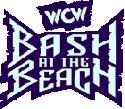
Bash at the Beach was a yearly professional wrestling pay-per-view (PPV) event produced by World Championship Wrestling (WCW). It was the company's PPV for the month of July, held from 1994–2000. As the title implied, the show centered on a beach theme.

Clash of the Champions is an American series of professional wrestling television specials that were produced by World Championship Wrestling (WCW) and Jim Crockett Promotions (JCP) in conjunction with the National Wrestling Alliance (NWA). The specials were supercards comprising pay-per-view caliber matches, similar to the World Wrestling Federation's Saturday Night's Main Event series. The Clash of the Champions shows were famous for typically not airing commercials during matches even though many of these matches lasted 20 minutes or more.

Capital Combat: Return of RoboCop was a one-time professional wrestling pay-per-view (PPV) event from the National Wrestling Alliance (NWA) held under the World Championship Wrestling (WCW) name. Capital Combat took place on Saturday, May 19, 1990, at the D.C. Armory in Washington, D.C. The show featured a promotional crossover with the imminent release of RoboCop 2, with RoboCop rescuing Sting from an attack by the Four Horsemen during the PPV.
Halloween Havoc is a professional wrestling event currently produced by WWE for the company's developmental brand, NXT. As the name implies, it is a Halloween-themed show held in October.
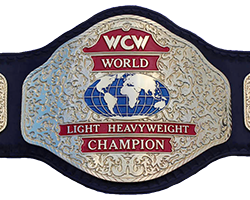
The WCW Light Heavyweight Championship was a professional wrestling championship that was contested in World Championship Wrestling (WCW) between 1991 and 1992. Conceived in 1991, the championship was first awarded as the result of a single-elimination tournament; its subsequent lineage ended when the final champion Brad Armstrong was stripped of the title due to injury. A second tournament to decide Armstrong's successor was announced, but never took place. The title was held by four different champions; the inaugural champion Brian Pillman was the only wrestler to win it on more than one occasion.

Michael Enos is an American retired professional wrestler. He is best known for his appearances with the American Wrestling Association (AWA) and World Championship Wrestling (WCW) under his birth name and with the World Wrestling Federation (WWF) as Blake Beverly. For much of his career, Enos teamed with Wayne Bloom as The Destruction Crew/The Beverly Brothers.
Wayne Bloom is an American retired professional wrestler. He is best known for his appearances with the American Wrestling Association (AWA) and World Championship Wrestling (WCW) under his birth name and with the World Wrestling Federation (WWF) as Beau Beverly. For much of his career, Bloom teamed with Mike Enos as The Destruction Crew/The Beverly Brothers.

WCW Saturday Night is an American weekly Saturday night television show on TBS that was produced by World Championship Wrestling (WCW). Launched in 1971 initially by Georgia Championship Wrestling, the program existed through various incarnations under different names before becoming WCW Saturday Night in 1992. Although initially the anchor show of the Turner Broadcasting-backed wrestling company, the September 1995 premiere of WCW Monday Nitro airing on sister station TNT usurped the show's once preeminent position in the company, as the primary source of storyline development and pay-per-view buildup.

The Great American Bash is a professional wrestling event currently produced by WWE, a professional wrestling promotion based in Connecticut. Created by Dusty Rhodes, the event was established in 1985 and was originally produced by the National Wrestling Alliance's (NWA) Jim Crockett Promotions (JCP) and was broadcast on closed-circuit television. In 1988, it began broadcasting on pay-per-view (PPV), and later that same year, JCP was rebranded as World Championship Wrestling (WCW), which seceded from the NWA in January 1991.
WCW/New Japan Supershow was an annual professional wrestling pay-per-view (PPV) event jointly produced by World Championship Wrestling (WCW) and New Japan Pro-Wrestling (NJPW). It was held in 1991, 1992 and 1993, and was promoted as "Starrcade" in Japan, but not billed as such in the United States due to WCW already having a show called "Starrcade" held each year in December. The show would be taped in Japan and then edited and aired in North America at a later date in WCW. The final two were also the first two January 4 Dome Shows. The events are some of the few pay-per-views not made available for streaming on the WWE Network service.

SuperBrawl was the inaugural SuperBrawl professional wrestling pay-per-view (PPV) event produced by World Championship Wrestling (WCW). The show took place on May 19, 1991 and was held at the Bayfront Center in St. Petersburg, Florida.
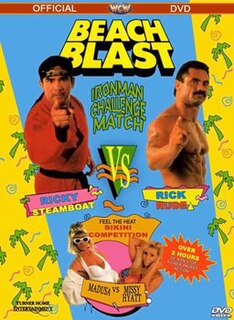
Beach Blast (1992) was the inaugural Beach Blast professional wrestling pay-per-view event produced by World Championship Wrestling (WCW). It took place on June 20, 1992 in the Mobile Civic Center in Mobile, Alabama.

Beach Blast (1993) was the second annual Beach Blast professional wrestling pay-per-view (PPV) event produced by World Championship Wrestling (WCW). It took place on July 18, 1993, at the Mississippi Coast Coliseum in Biloxi, Mississippi. In the main event the team billed as "the Superpowers" faced a team nicknamed "the Masters of the Power Bomb" as part of a longer running rivalry between the two sides.

WrestleWar '90: Wild Thing was a professional wrestling pay-per-view (PPV) event, produced by World Championship Wrestling (WCW) under the National Wrestling Alliance (NWA) banner. It took place on February 25, 1990, from the Greensboro Coliseum in Greensboro, North Carolina. This would be the second year in a row WCW promoted a PPV under the name "WrestleWar", a series that would include four shows in total. When the WWE Network launched in 2014 this show became available "on demand" to network subscribers.
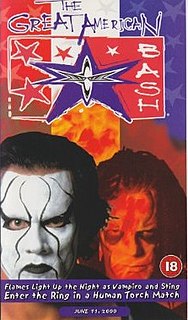
The 2000 Great American Bash was the 10th Great American Bash professional wrestling pay-per-view (PPV) event produced by World Championship Wrestling (WCW), and 14th Great American Bash event overall. It took place on June 11, 2000, at the Baltimore Arena in Baltimore, Maryland. This was the eighth and final Great American Bash held at this venue after the 1988, 1989, 1990, 1991, 1996, 1998, and 1999 events.

WCW/New Japan Supershow I, was a professional wrestling pay-per-view (PPV) event that took place on March 21, 1991 in the Tokyo Dome in Tokyo, Japan. It was co-promoted by New Japan Pro-Wrestling (NJPW), who hosted the event, and the US-Based World Championship Wrestling (WCW), which supplied a number of the wrestlers on the show. The event was the inaugural WCW/New Japan Supershow.
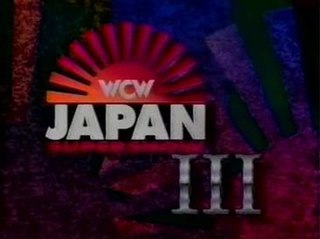
WCW/New Japan Supershow III took place on January 4, 1993, in the Tokyo Dome in Tokyo, Japan. The show would be the third and final show available on pay-per-view (PPV) in America under the name WCW/New Japan Supershow. In Japan it was promoted under the name "Fantastic Story in Tokyo Dome" and was the second annual NJPW January 4 Dome Show, NJPW's premier event of the year.
References
- ↑ "WrestleWar 1989 Review results". The History of WWE. Retrieved December 26, 2011.
- ↑ "WrestleWar 1990". Pro Wrestling History. February 25, 1990. Retrieved May 30, 2015.
- ↑ "WrestleWar 1991". Pro Wrestling History. February 24, 1991. Retrieved May 30, 2015.
- ↑ "WrestleWar 1992". Pro Wrestling History. May 27, 1992. Retrieved May 30, 2015.